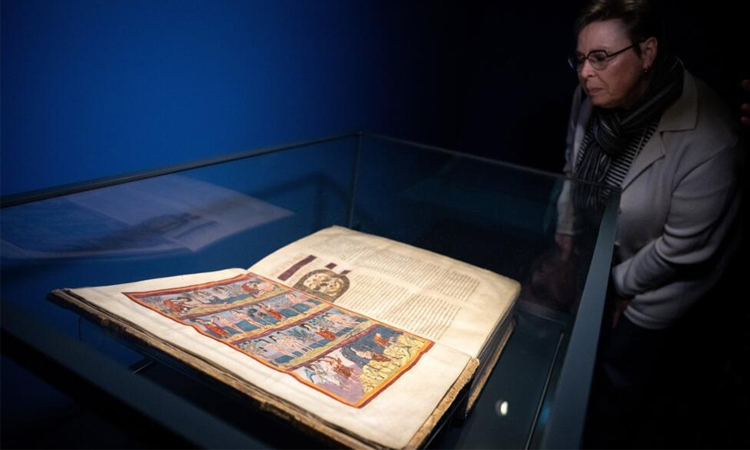News Flash
News Flash

DELÉMONT, Switzerland, March 7, 2025 (BSS/AFP) - The Moutier-Grandval Bible,
an illustrated ninth-century masterpiece considered one of the finest
manuscripts in the world, is back in Switzerland, where it miraculously
survived the ages in impeccable condition.
The priceless Bible was produced in Tours in France in around 830-840, before
making its way to Moutier-Grandval Abbey, in the mountainous Jura region in
northwestern Switzerland.
Now in the care of the British Library, the 22-kilogramme (50-pound)
manuscript is being loaned for three months to the Jura Museum of Art and
History in the region's tiny capital Delemont.
It is only the second time it has been loaned from London, after being shown
at the Jura Museum in 1981, when 32,000 people flocked to see it.
"We could even call it a miracle: this mediaeval masterpiece has survived the
ages, the circumstances of history; it has escaped ransacking, wars, fires,
revolutions, and has reached us in remarkable condition," said the museum's
director Nathalie Fleury.
When it returned on Tuesday, "the emotion was palpable: more than 1,200 years
of history were in our hands", she said.
Around 100 Bibles were produced during the same period in Tours, of which 18
have survived intact, including only three that are illustrated. The Moutier-
Grandval Bible is the best-known.
- 'Joy, awe and wonder' -
The Bible is going on show in the museum's basement, behind a thick steel
door. Sealed inside a glass cabinet, it is the only object in the bare,
darkened room.
It is open on the first page, showing a vivid illustration of the story of
Adam and Eve -- its colours still remarkably bright -- from the Book of
Genesis.
For optimum conservation conditions, only five people at a time are allowed
in the room, for five minutes only.
"The Moutier-Grandval Bible really is a masterpiece of scribal and artistic
endeavour," said Claire Breay, head of ancient, mediaeval and early modern
manuscripts at the British Library.
"It is one of the greatest treasures of the British Library," where it is
periodically displayed on rotation.
"This spectacular, 1,200-year-old, hand-written Bible, with this wonderful
decoration, is still bringing people together and bringing, joy, awe and
wonder to everyone who sees it."
The 450 leaves, or 900 pages, measure 50 by 37.5 centimetres (20 by 15
inches), with text written in two columns of 50 to 52 lines each. The skins
of 210 to 225 sheep were required to produce the parchment.
It contains four full-page illustrations and around 20 copyist monks worked
on the text, written in Latin in highly legible Carolingian minuscule script.
"It's very emotional to see it in real life: it's completely different from
seeing a reproduction of it in a book or online," said book historian and co-
curator Angeline Rais.
"People can see how big it is, how beautiful the colours and the gold still
are," she told AFP.
- Unravelling the mysteries -
"There's a lot of mystery around the Bible," said Rais.
How it came to Moutier-Grandval remains uncertain.
The Bible was left behind by canons and forgotten about until it was found,
according to legend, in a Delemont attic in the late 1810s or early 1820s. It
was sold to an antiques dealer in 1822.
It was eventually sold to the British Museum in 1836 for o750, or $93,600 in
today's money.
With much of its back story so little known, the Bible even today remains
shrouded in a degree of mystery: how it was transported from London to
Delemont, and all matters of security, remain a guarded secret.
Rais said it had "enormous" resonance for the region.
The founding of Moutier-Grandval Abbey, in around 640, is seen as the
starting chapter in local history.
"There is a really, really strong link between the community here of
Delemont, of Jura, and the Bible," Rais told AFP.
The exhibition opens to the public from Saturday until June 8.
Research continues on the Bible, notably on the parchment and the pigments
used in the illustrations.
The museum's experts hope that the Bible will be displayed in the Jura again,
and when it does, that studies will have finally unravelled the mysteries of
its long journey.